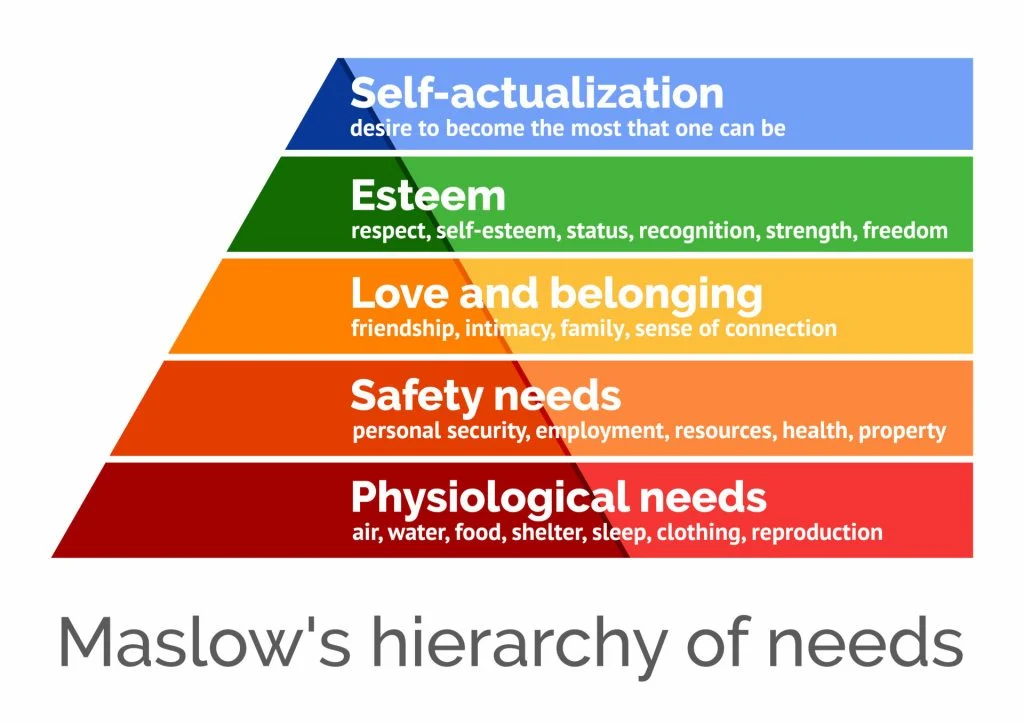Maslow’s Hierarchy of Needs and Its Relationship to Personal Growth
Abraham Maslow, a prominent psychologist of the 20th century, introduced a groundbreaking theory that explains human motivation through a structured hierarchy of needs. This hierarchy, often visualized as a pyramid, serves as a model for understanding the progression of individual growth, emphasizing the idea that certain foundational needs must be met before one can pursue higher, more abstract desires.

Basics of Maslow’s Hierarchy
Maslow’s Hierarchy of Needs categorizes human needs into five primary levels:
- Physiological Needs: At the pyramid’s base, these are the fundamental requirements for human survival. This includes needs for food, water, shelter, sleep, and breathing.
- Safety Needs: Once physiological needs are addressed, individuals seek safety and security. This encompasses personal security, financial security, health, and protection from adverse events or conditions.
- Love and Belongingness Needs: This level is about interpersonal relationships. People have a need for friendships, romantic attachments, family, and social community, aiming to overcome feelings of loneliness or alienation.
- Esteem Needs: This category is further divided into two segments:
- Lower Esteem Needs: Recognition from others, including respect, status, and attention.
- Higher Esteem Needs: The need for self-respect, including feelings of competence, mastery, and achievement.
- Self-Actualization: At the pinnacle of the pyramid, this is the realization of one’s potential and the quest to become everything one is capable of becoming. It includes the pursuit of knowledge, aesthetic experiences, and personal growth.
Later in his career, Maslow introduced a sixth stage, Self-Transcendence, which goes beyond self-actualization. It involves the pursuit of goals outside oneself, like altruism and spirituality.
Maslow’s Hierarchy and Personal Growth
Maslow’s theory is intrinsically tied to personal growth in the following ways:
- Framework for Personal Development: By understanding where one stands on the hierarchy, individuals can identify which needs are satisfied and which areas require focus. This clarity aids in plotting a path for self-improvement.
- Foundation for Well-being: Maslow’s hierarchy underscores the importance of fulfilling basic needs as a prerequisite for mental and emotional well-being.
- Drive for Self-Actualization: Maslow’s pyramid propels individuals towards their highest potential. Recognizing and striving for self-actualization can be a lifelong journey, encouraging constant self-assessment and growth.
- Understanding of Motivations: By discerning which stage of the hierarchy one is in, individuals can better comprehend their motivations, aiding in decision-making and setting life priorities.
- Interpersonal Relationships: By acknowledging the importance of love and belongingness, Maslow’s theory highlights the role of social connections in personal growth and well-being.
- Recognition of Esteem: Esteem needs emphasize the role of self-respect and respect from others in feeling accomplished and valuable, crucial elements for personal growth.
Applications in Modern Context
Maslow’s Hierarchy of Needs has permeated various fields:
- Education: Teachers and educators use the hierarchy to understand students’ needs, ensuring that basic requirements are met to create an environment conducive to learning and growth.
- Business and Management: Leaders use the hierarchy to motivate employees, recognizing that when basic needs are fulfilled, employees are more likely to be productive and engaged.
- Therapy and Counseling: Therapists use the hierarchy to comprehend the underlying issues clients face, tailoring their approach to help individuals progress through the levels.
Critiques and Considerations
While Maslow’s theory has been influential, it’s not without criticisms:
- Cultural Bias: Critics argue that the hierarchy is too Western-centric and may not apply universally across diverse cultures.
- Fluidity of Needs: Some believe that the hierarchy is too rigid and that humans can pursue higher-level needs even if their basic needs aren’t fully met.
- Empirical Support: The strict hierarchy presented by Maslow lacks comprehensive empirical validation.
Despite these critiques, the core concept—that humans have a range of needs that drive their behavior and aspirations—remains a powerful insight into human nature.
Conclusion
Maslow’s Hierarchy of Needs, with its structured representation of human motivations, offers a profound understanding of personal growth. By emphasizing the progression from basic survival needs to the quest for self-actualization, Maslow provides a roadmap for individuals aiming for personal development. Whether utilized as a self-assessment tool, a framework for educators, or a model for business leaders, the hierarchy remains a cornerstone in discussions about human potential and fulfillment. As individuals navigate the complexities of modern life, Maslow’s insights remind us of the fundamental needs and higher aspirations that propel us forward.